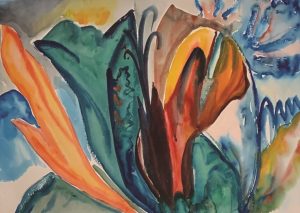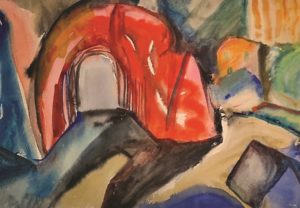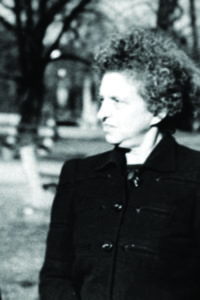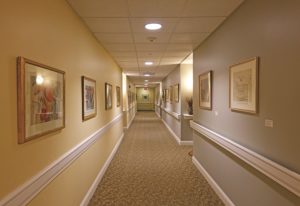If you want to see Dorothy Loeb’s paintings, the best place to go is not a museum but the Residences at Seashore Point, at 100 Alden St. in Provincetown. Specifically, the third floor. They are on long-term display there on loan from the Bakker Gallery, brightening up the cream-colored walls and carpeted floors. Bakker is also showing Loeb’s work online at Artsy.net.

One example is Flower, a colorful, semi-abstracted watercolor. In some parts of the painting, you can see dry brushstrokes; in others, the watery blues, greens, reds, and yellows mingle together. There are also several Fantasy Landscapes by Loeb. In one, you can make out a red portal in the side of a mountain, a cascading waterfall, and a house with tiny green windows. Another shows a rugged landscape with trees and a cobalt blue lake.
That’s one interpretation, anyway. Loeb’s Fantasy Landscapes are somehow familiar yet indescribable. Dreamlike shapes morph into hills and rivers, plants and animals. This is true, to some extent, of all abstract or semi-abstract art, but especially so in work by Loeb.
These landscapes, of which there are eight, were painted around 1928, when Loeb was mid-career, according to a chronology compiled by her descendent Catherine Loeb Schmidt and made available on the Provincetown Artist Registry.
 But a great deal of Dorothy Loeb’s history is uncertain or shifting — not unlike her watercolors. Born in July 1887, she spent much of her early life in Chicago, studying at the Art Institute. She was probably first introduced to Matisse’s work when the Armory Show traveled to Chicago in 1913.
But a great deal of Dorothy Loeb’s history is uncertain or shifting — not unlike her watercolors. Born in July 1887, she spent much of her early life in Chicago, studying at the Art Institute. She was probably first introduced to Matisse’s work when the Armory Show traveled to Chicago in 1913.
She made fast friends with Provincetown painter Blanche Lazzell, but it’s uncertain when they first met. It could have been between 1915 and 1917, when Loeb came to Provincetown to study with Charles Webster Hawthorne. Or it may have been in 1923, when both were studying with Fernand Léger in Paris. Later, in 1927, both Lazzell and Loeb served on the committee in charge of the “First Modernistic Exhibition” at what was then the Provincetown Art Association (and later Museum — PAAM).
Local gallerist and art historian James Bakker points out that Léger’s influence is especially apparent in Loeb’s watercolors. “There’s a spiritual, fantasy, imaginative thing that probably goes back to when she studied in Paris,” he says.

Loeb was Jewish and a socialist, holding meetings on establishing an “Artist and Writers Union” at her studio in Provincetown. In addition to watercolors, she painted murals for the federal Works Progress Administration, as well as monotypes that have been compared to those by Ross Moffett. Bakker says that as Loeb got older, her work shifted dramatically, getting more and more abstract.
She spent, at the very least, summers in Provincetown until the 1940s, then moved to Mexico. She died on July 23, 1971 at a care home in Los Angeles. She was 84.
Like Lazzell and Edith Lake Wilkinson, Loeb never married, which has led some to speculate about her sexuality. Bakker writes in his essay “Lazzell and Loeb: Women on the Edge of Modernism,” in American Art Review, that these artists “had to be careful not to antagonize each other or offend the male hierarchy lest they be deemed as Sunday lady painters and relegated to show their work at Sunday teas.”
The mystique of Loeb’s watercolors might partly arise from how she dealt with abstraction. A 1929 issue of the Milwaukee Journal Sentinel, on the occasion of a show at the city’s Layton Art Gallery, overhyped her painting style. A caption says, “Dorothy Loeb, Provincetown, Mass., paused in her work to explain theories which makes critics raise the originality of her art.” A paragraph heading calls her work “trade-marked.”

Yet what Loeb says in the article isn’t particularly revolutionary. “I work from the abstract to the concrete, instead of from the concrete to the abstract,” she says. “In the case of purely imaginative paintings, the representation, if there is any, is a product of the artist’s inner consciousness.” In abstraction, on the other hand, the artist “takes the material at his disposal and, by arranging or distorting it or both, adapts the subject to his own purpose in forming a pattern.” She also remarks on the importance of color, and how the watercolor medium discourages revision, making her method more difficult.
Essentially, Loeb paints, then decides what she’s painting. And it is with this open mind that viewers should approach her art.
“Women were the underdogs in all this,” says Bakker. “Many fell into obscurity after they died because they weren’t out there promoting, or their relatives had a sentimental attachment.” Fortunately, Loeb’s art has been saved from this fate. But she is still underappreciated.



